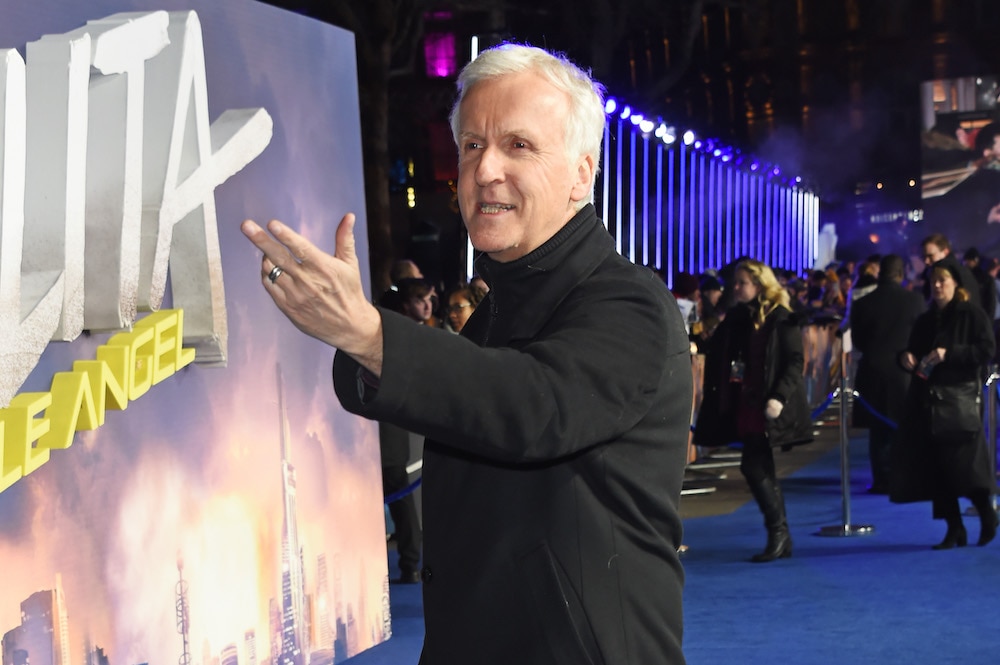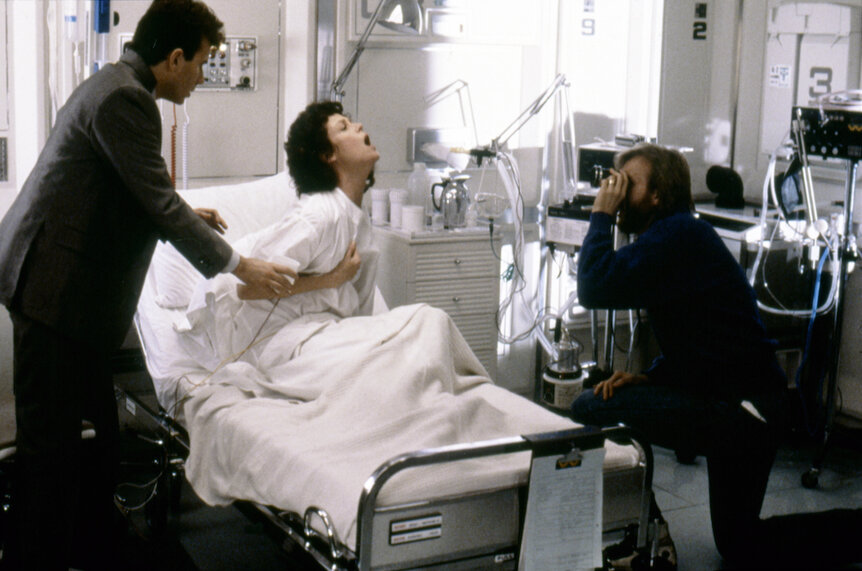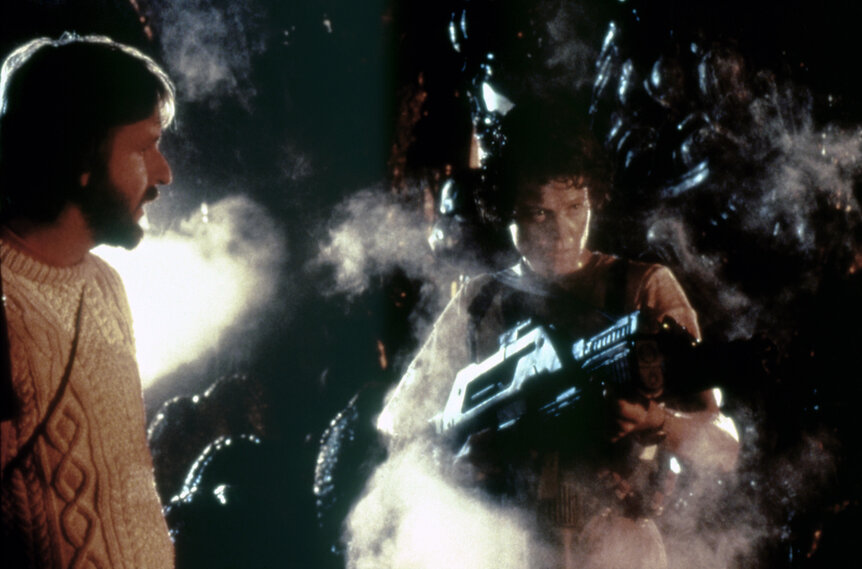Create a free profile to get unlimited access to exclusive videos, sweepstakes, and more!
James Cameron on how drawing as a kid helped prepare him for a life of filmmaking
Pick up that pen and pencil, aspiring directors!

If you ever want to make it in Hollywood as a big-shot director to the point where epic movie trailers describe you as a "visionary," you may want to consider beefing up your portfolio as an illustrator first. Hey, it worked for James Cameron — and that dude has an Oscar! Seriously, though, the acclaimed writer-director behind such cultural touchstones as The Terminator, Aliens, True Lies, Titanic, and Avatar was always destined for an industry that thrives on creativity and innovation.
Tech Noir: The Art of James Cameron — a new book from our good friends over at Insight Editions — tracks the filmmaker's artistic roots, which date back to his childhood when he would sketch and paint all the time (fun fact: he won a Halloween illustration contest held by a local bank branch three years running). SYFY WIRE had the honor of catching up with Mr. Cameron during a limited press roundtable last week and asked him how he thinks his artistic style has evolved over the decades.
"I think in those early years, you can see a steady progression of technique. That’s just about drawing all the time," he told us. "Like an athlete doing reps, you just draw, draw, draw. And you get better. Your eye-hand coordination, your ability to convey lighting [and] composition gets better. And then it sort of peaked in my early 20s or mid-20s, I guess, and then I started making films and my artistic expression shifted to cinema."
Continuously drawing, he explained, imparts a number of critical lessons for a professional career in the visual medium that is filmmaking: "How do you compose an image? What do you put in the foreground? What do you put in the mid-ground? What has the greatest narrative impact? I go back to learning to draw from comic books, where it’s what’s in the frame and what’s not in the frame. I think that’s a really good proving ground for any artist that wants to go into filmmaking — whether it’s through the more obvious channel of animation or just kind of directly going in through art and design into directing, which, I know, for example, Ridley Scott did."
Before he got his first big break directing the 1978 Roger Corman creature feature cult classic Piranha, Cameron worked for Corman's New World Pictures, helping craft visual effects for movies like Battle Beyond the Stars (essentially a quick cash-in on the Star Wars craze in the late '70s and early '80s) and John Carpenter's dystopian tour-de-force, Escape From New York.
"I sort of went in through the side door of design, worked as a production designer [and] art director for awhile, and then jumped to directing," Cameron recalled. "But I think all of that drawing and painting technique, use of light, use of color, use of black and white, compositional elements — even thinking in lenses. Are you stacking the image graphically like you would with a longer lens or are you distorting the image and being very close to something in an almost natural way?"
He continued: "Some of my drawings even look like there was some lens selection involved, so I know that I was really exercising all those muscles long before I got to have a crew and cameras and actors. When I was doing all that drawing and painting, I think I was secretly — or not even consciously — wanting to be a filmmaker. But it wasn’t easy back then. When I was in my 20s, if you had a camera and you could record sound and you could synchronize the sound and the picture? That was a big deal! ... I mean, today, we don’t even think twice about it and the tools are quite democratized, but filmmaking seemed a little far away for me, so I guess I was just building muscle doing drawings and paintings and telling stories visually."
Cameron gave a lot of credit to his mother, Shirley, describing her as a "mentor" figure who helped foster his creative side and "taught me to value art; that art was a thing that boys could do."
"It turned out I could do it and she encouraged me to that life of the mind, to think, to tell stories, and all of that sort of thing," he added. "And she was an artist herself and she was in the local art society and so on. She created a framework, but she was also this amazing character that would come home and say, ‘Let’s join a geology class!’ So we went and joined a geology class. I literally would get out of school early as I could, so I could go to a class I wanted to do. Then we’d go out and hunt rocks and find crystals. One day, she came home in a uniform with a rifle and said, ‘I’ve joined the Army Reserve!’ I was like, ‘Wow! Moms can do that? I didn’t know that.’"
Having grown up with such a supportive and strong mother, Cameron entered Hollywood with a different notion of female archetypes in cinema. This radical idea — and make no mistake about it, this was incredibly groundbreaking for its time — gave rise to some of the most badass heroines in pop culture like Sarah Connor and Ellen Ripley.
"I kind of looked at Hollywood and women were basically girlfriends and wives and victims and all of the cliches," he said. "I thought, ‘Well, maybe this is a place I can make a difference.’ So when I wrote Terminator, I wrote it from that perspective and then it just became a motif for me. I was frankly stunned by how much of a big deal people made out of these strong women that I wrote. It was like, ‘What’s the big deal, guys? I sort of noticed that you’re not doing it, but I don’t see why you wouldn’t.’"
Cameron also discussed the impact his childhood — which was smack dab in the middle of the counterculture movements of the 1960s and '70s — had on the movies he'd ultimately make.
"It was a very vivid period, both creatively and movies and art and literature and all that. It was a very iconoclastic time," he concluded. "There was a lot going on, it was a very turbulent time in society: Civil Rights and the anti-war movement and drugs, free love. It sort of felt like the world was recreating itself and I think I fed on that energy. Exploration. Space exploration was one of the biggest hopeful topics of the time and exploration of the oceans. You see all of that reflected in [my early] drawings, so it was a formative time for a lot of ideas that I’ve simply played out since then. I had strong sense of environmental conscious when I was 16, 17, 18, and I’m still playing that out to this day. So I think I kind of — I don’t want to say I crystallized into who I am today — but I’m still working out those themes and those ideas and I still find them as relevant and important today as they were then. I’m just doing it on a different canvas, I’m doing it with film, with digital effects and all that."
Tech Noir: The Art of James Cameron is now on sale from Insight Editions for $75.




























